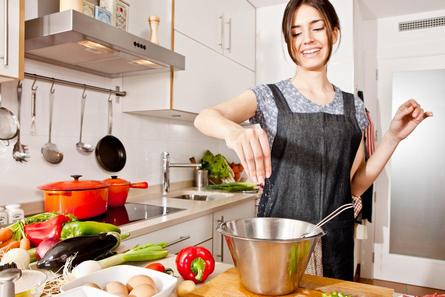All you need to know about food safety

Food Safety Tips
Food safety is an important component of healthy eating. By keeping and preparing foods safely at home and being alert to unsafe food-handling practices when eating out, you will decrease your risk of food-borne illness. There are a few basic food safety principles that work together to reduce this risk: Clean, Food Handling, Storage, Separate, Cooking and Eating Out. Be in control of the foods you eat!
Clean & Food Handling
- Wet hands with clean running water and apply soap. Use warm water if it is available. Rub hands together to make a lather and scrub all parts of the hand for 20 seconds. Rinse hands thoroughly and dry using a clean paper towel. If possible, use a paper towel to turn off the faucet.
- To prevent cross-contamination, after each use of a cutting board, wash with hot water, soap and a scrub brush. Then sanitize with bleach or other commercial kitchen-cleaning agents.
- To prevent bacterial growth in your kitchen, be sure to clean your sink drain, disposal and connecting pipe periodically with chlorine bleach or other commercial kitchen-cleaning agents.
- At least once a week, throw out refrigerated foods that should no longer be eaten. Cooked leftovers should be discarded after 4 days; raw poultry and ground meats, 1 to 2 days.
- Clean the inside and outside of appliances. Pay particular attention to buttons and handles where cross-contamination to hands can occur.
- Rinse fresh vegetables and fruits under running water just before eating, cutting, or cooking. Even if you plan to peel or cut the produce before eating, it is important to thoroughly rinse it first to prevent microbes from transferring from the outside to the inside of the produce.
- Use smooth cutting boards made of hard, nonporous material, such as plastic. Disposable cutting boards are another option for quick, yet sanitary, clean-up.
- Foods should be thawed in the refrigerator, under cold running water, or in the microwave oven. Foods defrosted in the microwave oven should be cooked immediately after thawing.
- Keep hot foods hot and cold foods cold! Leftover food should be refrigerated as soon as possible, or within two hours after cooking.
Storage
- Always look for sell-by or expiration dates on perishable foods before you purchase them. If the food or beverage has expired or will be expiring soon, don't buy it.
- Keep a thermometer in your refrigerator at all times. Your refrigerator should stay at 40 degrees F (4 degrees C) or cooler to slow the growth of most bacteria.
- By following the recommended storage times, you'll decrease your risk of eating spoiled, and potentially dangerous, foods.
Separate
- Separate foods when shopping. Place raw seafood, meat and poultry in plastic bags. Store them below ready-to-eat foods in your refrigerator.
- Separate foods when preparing and serving. Always use a clean cutting board for fresh produce and a separate one for raw seafood, meat and poultry. Never place cooked food back on the same plate or cutting board that previously held raw food.
Cooking
- Buy a kitchen thermometer! A food thermometer should be used to ensure that food is safely cooked and that cooked food is held at a safe temperature until eaten.
- Cook food to safe internal temperatures. One effective way to prevent illness is to check the internal temperature of seafood, meat, poultry and egg dishes. Make sure that your eggs are cooked! Avoid eating raw dough or cake mix that contains eggs. Avoid eating runny fried eggs. Cook all raw beef, pork, lamb and veal steaks, chops and roasts to a safe minimum internal temperature of 145 F. For safety and quality, allow the meat to rest for at least 3 minutes before eating. Cook all ground beef, pork, lamb and veal to an internal temperature of 160 F. Cook all poultry, including ground turkey and chicken, to an internal temperature of 165 F.
- Keep foods at a safe temperature. Hold cold foods at 40 F or below. Keep hot foods at 140 F or above. Foods are no longer safe to eat when they have been in the danger zone between 40-140 F for more than 2 hours.
Eating Out
- Avoid raw or undercooked foods (meat, fish, poultry, eggs, sauces, dressings and desserts) when eating out. Ask how foods are prepared and request that foods be cooked well done.
- Make sure buffet tables are clean and that foods are covered with a guard.
- Hot foods should arrive at your table hot, whereas cold foods should be served cold.
- Take a look around the restaurant. Are the tables, floors, walls and countertops clean? Are the staff using tongs and wearing gloves and hairnets? How do the restrooms look?